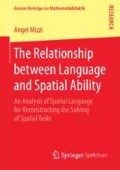Abstract
In analysing how students solve spatial geometrical tasks, I am interested in how language can play a role in the students’ solving process. In a wider context, I intend to study the relationship between language and spatial ability for a deeper understanding of language and content learning in mathematics education. This section provides an overview of the theoretical frameworks in both domains of language and spatial ability, followed by theoretical considerations on the integration of both domains based on findings from previous literature.
Access this chapter
Tax calculation will be finalised at checkout
Purchases are for personal use only
Preview
Unable to display preview. Download preview PDF.
Author information
Authors and Affiliations
Corresponding author
Rights and permissions
Copyright information
© 2017 Springer Fachmedien Wiesbaden GmbH
About this chapter
Cite this chapter
Mizzi, A. (2017). Theoretical framework. In: The Relationship between Language and Spatial Ability. Essener Beiträge zur Mathematikdidaktik. Springer Spektrum, Wiesbaden. https://doi.org/10.1007/978-3-658-20632-1_2
Download citation
DOI: https://doi.org/10.1007/978-3-658-20632-1_2
Published:
Publisher Name: Springer Spektrum, Wiesbaden
Print ISBN: 978-3-658-20631-4
Online ISBN: 978-3-658-20632-1
eBook Packages: Mathematics and StatisticsMathematics and Statistics (R0)

